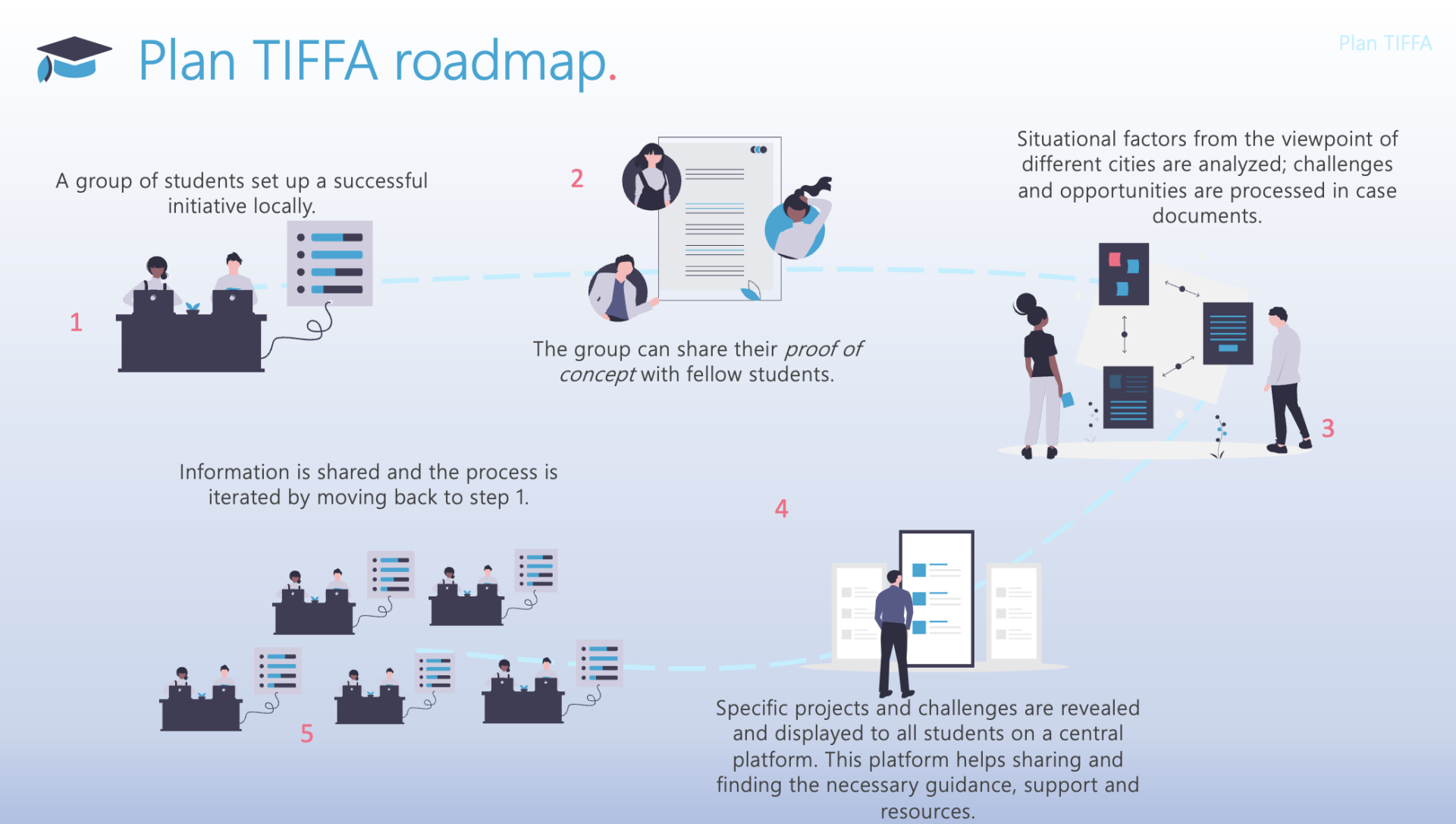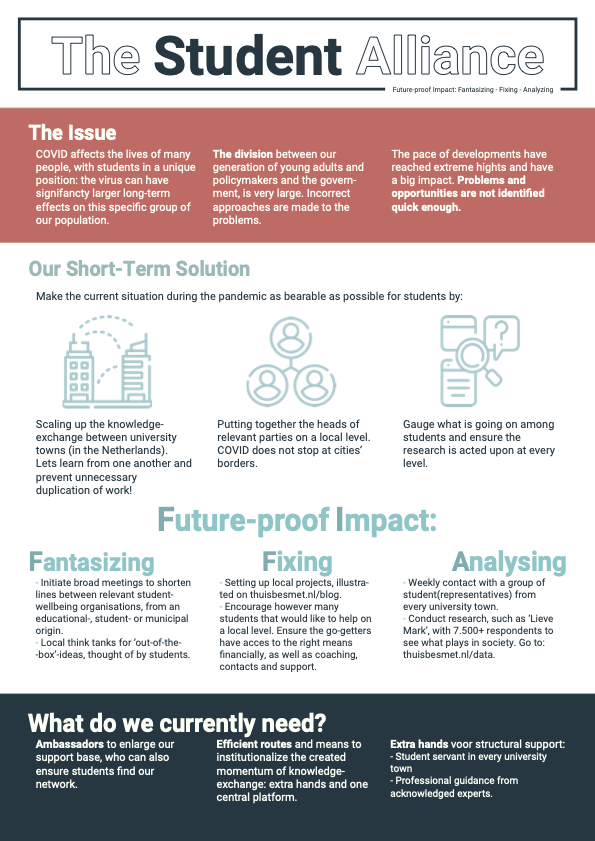Plan TIFFA
Basic information
Project Title
Full project title
Category
Project Description
"Talk with students, not about them." By institutionalizing 'student civil servants' at municipalities, one can improve the conversation regarding the needs of students, which is now important more than ever. In cooperation with this, 'Social & Wellbeing Hubs' will be created to encourage students, giving tools and training to improve social engagement. Inspiring and supporting students to make an impact on their own world. Increase knowledge exchange between each hub from other cities.
Geographical Scope
Project Region
Urban or rural issues
Physical or other transformations
EU Programme or fund
Which funds
Description of the project
Summary
The connection between students in the city and the municipality can be fostered. As a result of the pandemic students were hit hard by the implemented measures. To start the conversation regarding the needs of students is now important more than ever. Yet, to reach students and really work together is more difficult than expected (some studies reveal). At the same time without insights in the students needs, appropriate services can’t be established. However, this requires proper coordination. The current situation is often fragmented, since the pandemic there have been introduced multiple new initiatives by governments, education institutes, health services and private initiatives. A student civil servant has the opportunity to provide a clear overview in what has done by other organizations and is able to connect initiatives to each other. Besides this, the benefit of deploying a student civil servant is the direct connection with the target group and the topics that concern students.
Student Civil Servant: A student civil servant is a civil servant who, in addition to his/her studies, works multiple hours a week in service of the applicable municipality. This proposal is based on knowledge and experiences gained from past and current student civil servants working for other municipalities in The Netherlands, where it really is a proof of concept.
Social Hub: Creating a ‘Social Hub’ amplifies the added value of a student civil servant. It is a place where students are encouraged, receive tools and training to make impact as ‘students helping students’, and ‘students helping the society’. It provides a platform to fully enable the student’s social and volunteering ambitions. A mental wellbeing hub should later/parallel be integrated with such a Social Hub. The team of a Social Hub provides a linking pin between educational institutions, municipalities (in cooperation with the student civil servant) and all other stakeholders.
Key objectives for sustainability
Although the concept is mainly digital, there are still components which contribute to environmental sustainability.
"don't re-invent the wheel": in these fast-changing times, a lot of challenges can be tackled locally. However, quite some of them have components which happen at most (European) cities. For example the impact on wellbeing by the imposed restrictions regarding Corona. The increase in use of social media. The increase in use of online meetings. The fact that international students suffered badly from loneliness since they weren't adopted (yet) in a student community. Most cities have solutions for these problems. Yet, a fast communicating network on student level to exchange best practices doesn't exist yet on a local, but international scale. By implementing this, there is less need to organize think tanks and task forces; one can more simply re-use on of the proven best practices in other cities. And if it doesn't work, the findings can be added to the database to iterate for an optimal solution.
Key objectives for aesthetics and quality
Our generation (the present-day students) somehow tends to be distracted quite quickly, and spends hours on social media these days. Yet, this comes with some perks. The beauty of our generation is that we communicate extraordinary fast. Using this, we a Social Hub can identify signals from all student communities way faster and act properly. By joining forces with the more structural and powerful player, the municipality (via the student civil servant), the relevant civil servants can address this problem long term and embed it in policy making.
Quality of experience beyond functionality
In The Netherlands, there are already 11 student civil servants (almost all new since this year) and the student, as well as municipalities, have benefits from this cooperation. Where the original functionality was to gain insight on the wellbeing status of students, the student civil servants and Social Hubs are driven by their own target group. One gets more traction of fellow students and students gain a sense of belonging by participating in societal challenges. There’s one Social Hub in Delft cooperating with their student civil servant. All the student civil servants periodically gather in online meetings to discuss how to improve themselves and to exchange insights regarding social engagement of students in their city as well as their wellbeing.
By initializing student civil servants and Social & Wellbeing Hubs, a totally new grid is generated. Not focussed on official representation, but by social impact and informal connections. For example, by sending questionnaires on whatsapp asking how students were feeling, using this grid in The Netherlands over 15.000 students have responded in total. To help others during the first lockdown of Corona, some students founded a platform 'just people who want to help people', and got 45.000+ volunteers after just one week.
Key objectives for inclusion
This project is all about inclusion and is founded on the frustration that students did not feel understood during the Corona times. It is important to include students in conversations which directly have an impact on them. Talk with student, not about them. By institutionalizing a student within the municipality, the bridge between policy, civil servants and the student community is build in a low key manner. By setting up Social Hubs and Wellbeing Hubs, it's possible to lay focus on gathering as much different student communities and boards as possible. Student fraternities, sport clubs, student faculties, etc. are all put together to form one point of contact for the municipality and educational institutions.
By further involving students in policymaking, appropriate customization can be provided. By actively mapping student problems, solutions can be delivered with a future-proof impact. In several cities with a student civil servant, his/her position has been found to provide an effective way to discuss with students, not for students. The student civil servant has the network to efficiently reach the appropriate contacts.
Creating a ‘Social Hub' means creating a place where students are encouraged, receiving tools and training to make impact as ‘students helping students’, and ‘students helping the society’. It provides a platform to fully enable the student’s social and volunteering ambitions.
Physical or other transformations
Innovative character
By involving students in policymaking, the target group is really integrated in the process. On national scale (and with Belgium), this is already a proven concept, but to further include different ideas, it is beneficial to scale up the knowledge exchange between different cultures. More ideas can be added to the database and less think tanks and task forces have to be organized. A decentralized communication network is initiated by and for students. Due to our generational characteristics, we communicate extremely fast. By connecting in solid structures (municipalities), it is a long term proof plan. Of course, proper coordination is necessary on EU-level to address the bottom-up signals and grass root projects.
This way of working can be used for other purposes. On the one hand, different target groups can be involved in a similar manner as students. On the other hand, the same group (students in this case) can make use of the connections, grid & network to tackle new societal problems. (Not so) luckily for us, there are many such problems to tackle in the upcoming decennia..


